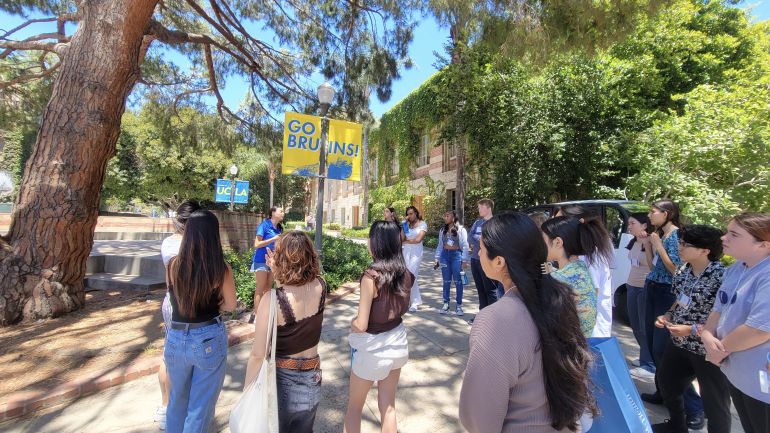This post was written by high school students from the Summer Research Boot Camp in the labs of Andrew Fuligni and Sandra Graham at UCLA, supported by UCLA Center for the Developing Adolescent, and led by Piper Harris, Naomi Kline, Xochitl Arlene Smola, and Ava Trimble.
By Kobe Wood and Bless Jellene Patawaran
Adolescence is a period when the complexities of adulthood and the strands of childhood are intertwined. Individuals from the ages of 10 to 25 embark on a journey through the uncharted waters of exploration and self-discovery. Through years of research studies with adolescents, it is evident that a brighter future is created through our understanding of this transformational era. During a span of two weeks, we explored this stage of growth in the UCLA CDA Adolescent Development Summer Boot Camp for high schoolers.
Week One: Sleep & Adolescent Brain Development
As teenagers, we find ourselves staying up late, whether due to extracurriculars or endless scrolling through our phones. Science explains that our brains during adolescence are on a shifted circadian rhythm (the body’s internal clock) compared to childhood or adulthood, leading to later sleep times. Strategies such as a reduction in academic workload can help students complete assignments at reasonable hours, while teachers have fewer papers to grade. Yet nothing is worthwhile unless there’s sleep regulation. Limited screen time and a consistent bedtime regimen can help youth improve their sleep quality. School start times and teens’ natural sleep cycles also often don’t align, resulting in fluctuations in cognitive stability (our ability to focus) and lack of concentration. Promisingly, this has caught the attention of some school districts, including a recent Los Angeles shift in school start times to 8:30 AM.
In addition to a shifted circadian rhythm, there are other internal changes happening within the brain during adolescence. In the boot camp, we gained an understanding of the role of heredity and experience (nature vs. nurture) in the dynamic growth we undergo. Our limbic system (the region of emotion and motivation) develops early, while our socioemotional and cognitive control systems continue to develop. As a result of these changes coupled together, we often experience a yearning for self-approval and acceptance, with increased willingness for risk-taking, explorative mindsets, and prosocial behaviors (helpful behavior toward others). In addressing the current urgency surrounding youth mental health, It’s crucial to note that emotional and behavioral changes are normal. It is extreme changes that can make individuals vulnerable to mental health issues.
Week Two: Friendships & School Diversity
We commenced week two with defining “friendship” and exploring the characteristics of a friend. In our discussion, we concluded that friendships must be egalitarian (equal), voluntary, and reciprocated. The label varies with the intimacy of the relationship:; a person whom you seek for companionship and security may be considered a best friend, whereas someone with a shared interest is an acquaintance. As a whole, friendships promote self-worth and alleviate feelings of loneliness. Because of the closer connection and extensive time spent together, adolescents tend to have higher self-disclosure rates (that is, they are more likely to share personal information) with friends than family members.
We analyzed two factors that spark the formation of friendships: homophily and propinquity. Individuals are likely to choose friends similar to themselves (homophily) and those who are readily available to them (propinquity). For instance, students on the first day of high school will interact with those who are seated beside them. Although homophily can refer to gender and age, it also includes race and ethnicity. Moreover, research on cross-ethnic friendships emphasizes the importance of diversity and close relationships with numerical majority group members to ease the adjustment of racial minority students in school settings (Mendoza-Denton, 2008). However, even if a school varies ethnically, that doesn’t mean each class does, as calculated by the Simpson’s Diversity Index. For example, AP, honors, and Magnet classes may overrepresent one racial or ethnic group.
Furthermore, adolescents naturally gravitate towards friends who share the same race. It is understood that a positive future is facilitated by open-mindedness from cross-ethnic friendships. The ultimate goal is to see more projects and activities in classes geared toward bringing different cultures and perspectives together.


